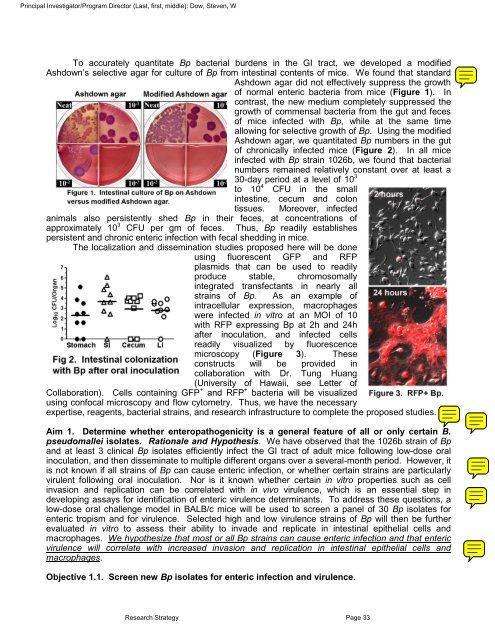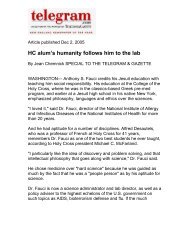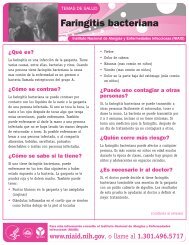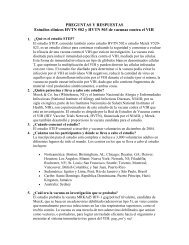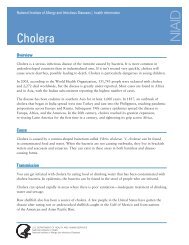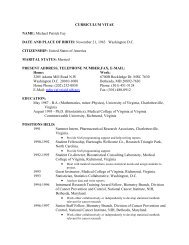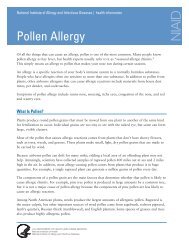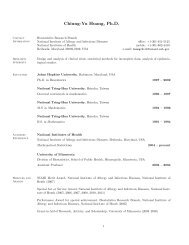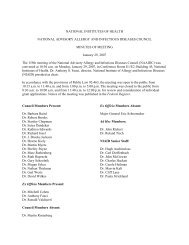Sample Grant Application - NIAID - National Institutes of Health
Sample Grant Application - NIAID - National Institutes of Health
Sample Grant Application - NIAID - National Institutes of Health
Create successful ePaper yourself
Turn your PDF publications into a flip-book with our unique Google optimized e-Paper software.
Principal Investigator/Program Director (Last, first, middle): Dow, Steven, W<br />
To accurately quantitate Bp bacterial burdens in the GI tract, we developed a modified<br />
Ashdown’s selective agar for culture <strong>of</strong> Bp from intestinal contents <strong>of</strong> mice. We found that standard<br />
Ashdown agar did not effectively suppress the growth<br />
<strong>of</strong> normal enteric bacteria from mice (Figure 1). In<br />
contrast, the new medium completely suppressed the<br />
growth <strong>of</strong> commensal bacteria from the gut and feces<br />
<strong>of</strong> mice infected with Bp, while at the same time<br />
allowing for selective growth <strong>of</strong> Bp. Using the modified<br />
Ashdown agar, we quantitated Bp numbers in the gut<br />
<strong>of</strong> chronically infected mice (Figure 2). In all mice<br />
infected with Bp strain 1026b, we found that bacterial<br />
numbers remained relatively constant over at least a<br />
30-day period at a level <strong>of</strong> 10 3<br />
to 10 4 CFU in the small<br />
intestine, cecum and colon<br />
tissues. Moreover, infected<br />
animals also persistently shed Bp in their feces, at concentrations <strong>of</strong><br />
approximately 10 3 CFU per gm <strong>of</strong> feces. Thus, Bp readily establishes<br />
persistent and chronic enteric infection with fecal shedding in mice.<br />
The localization and dissemination studies proposed here will be done<br />
using fluorescent GFP and RFP<br />
plasmids that can be used to readily<br />
produce stable, chromosomally<br />
integrated transfectants in nearly all<br />
strains <strong>of</strong> Bp. As an example <strong>of</strong><br />
intracellular expression, macrophages<br />
were infected in vitro at an MOI <strong>of</strong> 10<br />
with RFP expressing Bp at 2h and 24h<br />
after inoculation, and infected cells<br />
readily visualized by fluorescence<br />
microscopy (Figure 3). These<br />
constructs will be provided in<br />
collaboration with Dr. Tung Huang<br />
(University <strong>of</strong> Hawaii, see Letter <strong>of</strong><br />
Collaboration). Cells containing GFP + and RFP + bacteria will be visualized<br />
using confocal microscopy and flow cytometry. Thus, we have the necessary<br />
expertise, reagents, bacterial strains, and research infrastructure to complete the proposed studies.<br />
Aim 1. Determine whether enteropathogenicity is a general feature <strong>of</strong> all or only certain B.<br />
pseudomallei isolates. Rationale and Hypothesis. We have observed that the 1026b strain <strong>of</strong> Bp<br />
and at least 3 clinical Bp isolates efficiently infect the GI tract <strong>of</strong> adult mice following low-dose oral<br />
inoculation, and then disseminate to multiple different organs over a several-month period. However, it<br />
is not known if all strains <strong>of</strong> Bp can cause enteric infection, or whether certain strains are particularly<br />
virulent following oral inoculation. Nor is it known whether certain in vitro properties such as cell<br />
invasion and replication can be correlated with in vivo virulence, which is an essential step in<br />
developing assays for identification <strong>of</strong> enteric virulence determinants. To address these questions, a<br />
low-dose oral challenge model in BALB/c mice will be used to screen a panel <strong>of</strong> 30 Bp isolates for<br />
enteric tropism and for virulence. Selected high and low virulence strains <strong>of</strong> Bp will then be further<br />
evaluated in vitro to assess their ability to invade and replicate in intestinal epithelial cells and<br />
macrophages. We hypothesize that most or all Bp strains can cause enteric infection and that enteric<br />
virulence will correlate with increased invasion and replication in intestinal epithelial cells and<br />
macrophages.<br />
Objective 1.1. Screen new Bp isolates for enteric infection and virulence.<br />
Research Strategy Page 33


